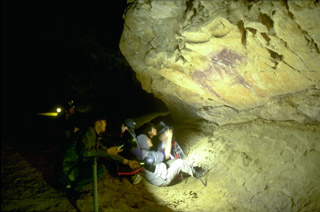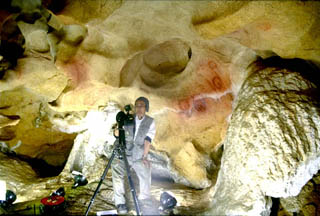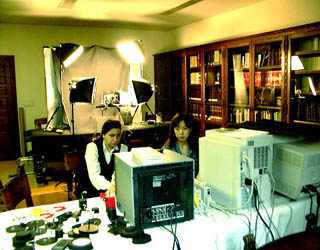|
|

PhotoVR Multimedia Database

"Paleolithic Arts in Northern Spain"

This digital archiving project was realized this way

The multimedia database presented here was a project carried out by a large team of photographers and software experts based at the company Texnai of Tokyo, working with a group of researchers in Paleolithic art in the Cantabrian region, linked with the Department of Historical Sciences at the University of Cantabria (UC), Santander.
This PhotoVR multimedia database presented here was realized as a result of the co-project between a Japanese multimedia company Texnai, Inc. and the Department of Historical Sciences at the University of Cantabria (UC), Santander.with a finacial supports by the Ministry of International Business and Industries of Japan through the quasi-government organization IPA(Information-technology Agency) and MMCA(Multimedia Contents Association).
 The technical basis of the project, and several of its aims, were originally presented by Takeo Fukazawa at the 4th Congress of Japanese Studies in Spain, held in Santander in September 1997. At the same time, the first contacts with the prehistorians taking part were able to define the main features and objectives of the database. Fortunately, a few weeks later, the Japanese Ministry of International Trade and Industry, through IPA agency, selected the project from over a hundred applications, and guaranteed its financial backing and development. In this way, between the end of 1997 and the start of 1998 the fieldwork could be programmed, and the structure of the database was designed, integrating documentary and multimedia elements. Finally, an agreement was drawn up between Texnai and the Department of Historical Sciences, and this has governed the development of the project since March 1998.
The technical basis of the project, and several of its aims, were originally presented by Takeo Fukazawa at the 4th Congress of Japanese Studies in Spain, held in Santander in September 1997. At the same time, the first contacts with the prehistorians taking part were able to define the main features and objectives of the database. Fortunately, a few weeks later, the Japanese Ministry of International Trade and Industry, through IPA agency, selected the project from over a hundred applications, and guaranteed its financial backing and development. In this way, between the end of 1997 and the start of 1998 the fieldwork could be programmed, and the structure of the database was designed, integrating documentary and multimedia elements. Finally, an agreement was drawn up between Texnai and the Department of Historical Sciences, and this has governed the development of the project since March 1998.
 The concept and the technical basis of the project were originally presented by Takeo Fukazawa at the 4th Congress of Japanese Studies in Spain, held in Santander in September 1997. At the same time, the first contacts with the prehistorians taking part were able to define the main features and objectives of the database. Fortunately, a few weeks later, this project was adopted by IPA and MMCA from over a hundred applications and guaranteed its financial support. Then the basic program was immediately discussed between Tokyo and Santander by the net and the co-developemnt agreement was finally drawn up between Texnai and the Department of Historical Sciences in March, 1998 to realize this digital archiving project.
The concept and the technical basis of the project were originally presented by Takeo Fukazawa at the 4th Congress of Japanese Studies in Spain, held in Santander in September 1997. At the same time, the first contacts with the prehistorians taking part were able to define the main features and objectives of the database. Fortunately, a few weeks later, this project was adopted by IPA and MMCA from over a hundred applications and guaranteed its financial support. Then the basic program was immediately discussed between Tokyo and Santander by the net and the co-developemnt agreement was finally drawn up between Texnai and the Department of Historical Sciences in March, 1998 to realize this digital archiving project.
Most of the fieldwork was carried out in March and April 1998, briefly prolonged into June and July. The first team of photographers and technical peoples, accompanied by postgraduate students from UC, visited and photographed all the caves to be included, from the west of the region, Peña de Candamo in the center of Asturias, to Cueva de Ekain, in the east, near the Pyrenees and the French border. A second team, with a similar composition but with an even heavier load of equipment, took photographs of the most important objects of Paleolithic mobiliary art in the different museums and research centers in the region. All this work only became possible after obtaining the appropriate permits from a considerable number of authorities responsible for the management, conservation and, occasionally, research in archeological heritage: the Services of Historical Heritage of the Autonomous Communities of Asturias and Cantabria, and of the Diputaciones of Vizcaya and Guipúzcoa, as well as the Archeological Museum in Oviedo, Prehistorical and Archeological Museum in Santander, Research Center and Museum at Altamira, Basque Historical Museum in Bilbao, and Aranzadi Science Society of San Sebastián.
The different articles accompanying the Database and included in this book were written at the same time, during 1998. The photographs were processed and organized in Tokyo in summer and fall of that year, and shortly afterwards the comments were added to the photos of cave art, the descriptions to the examples of mobiliary art, and the different fields in the database were filled out, including the cartography, published drawings of the mobiliary objects, and references.
In this way, it was possible to present a preliminary version of the Database at the 1st International Cultural Heritage Exhibition, held at Magdalena Palace in Santander in November 1998. After solving a few minor problems, the first version of the database was presented in several centers in the Cantabrian region in March and April 1999: the University of Cantabria, Archeological Museum in Oviedo, Archive of the Basque Deputation in Bilbao, and Aranzadi Science Society in San Sebastián. Copies were made available for public use in each of these centers, and also in the Regional Museum of Prehistory and Archeology in Santander. Similarly, the Database was presented in different centers in Japan in December 1999 (National Museum of Ethnology in Osaka, Information Technology Faculty of Kansai University in Osaka, International Research Center for Japanese Studies in Kyoto, and the Humanities Faculty at Tokyo University). Immediately afterwards it was presented at the International Seminar "Représentations préhistoriques" (17eme Session, II-2000), directed by D. Vialou in Musée de l'Homme, Paris. In the last year and a half, a second version has been prepared for its publication, including an English translation, and the necessary adjustments have been made for storing the database in DVD or for its use in a PC as well as in a Macintosh .
Technical and Scientific Team
Producer / Director: Takeo Fukazawa (Texnai, Inc.)
Assistant Producer: Norie Hiraide (Texnai Inc.)
Academic Supervisors: César González Sainz (UC) and Roberto Cacho Toca (UC).
Rock art DB Documentation: Roberto Cacho Toca, Nerea Gálvez Lavín and Gustavo Trueba Villena (UC)
Mobiliary art DB Documentation: María José Samperio Aguilera (UC)
Field Assistant: Ignacio Castanedo Tapia (UC)
Database Customization: Shin Hamazaki (Texnai Inc.)
IPIX and Still Photo (Rock Art): Takeo Fukazawa and Hiroaki Seki (Texnai Inc.)
IPIX Building: Yoshinori Matsumoto (Texnai Inc.)
QTVR Object Movie (Mobile Art): Hiroaki Seki (Texnai Inc.)
QTVR Assistant: Yuki Fukazawa (Texnai Inc.)
QTVR Panorama: Shimon Sato (Texnai Inc.)
Video Shooting: Koji Nagasaka (Nagasaka Video Service, Tokyo), Shimon Sato (Texnai Inc.)
QTVR Software: Peter Sun (Texnai Inc.)
Academic Adoviser: Yuji Seki (National Museum of Ethnology, Osaka)
Underground photography in Altamira Cave: Pedro Saura (Madrid).
Translation Spanish-Japanese: Atsuko Yoshikawa, Yuji Seki (National Museum of Ethnology, Osaka),
Translation Spanish-English: Peter Smith (Asociación Cántabra para la Defensa del Patrimonio Subterráneo, Santander)
Texnai, Inc.
2-1, Udagawa-cho, Shibuya-ku, Tokyo, Japan. Tel:03-3464-6927 Fax:03-3476-2372
e-mail: paleoarts@texnai.co.jp
Copyright:Texnai, Inc.
|
|

